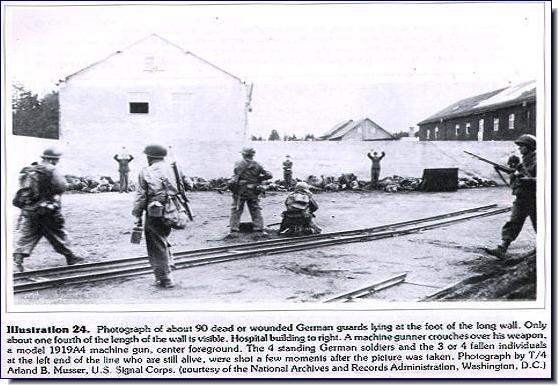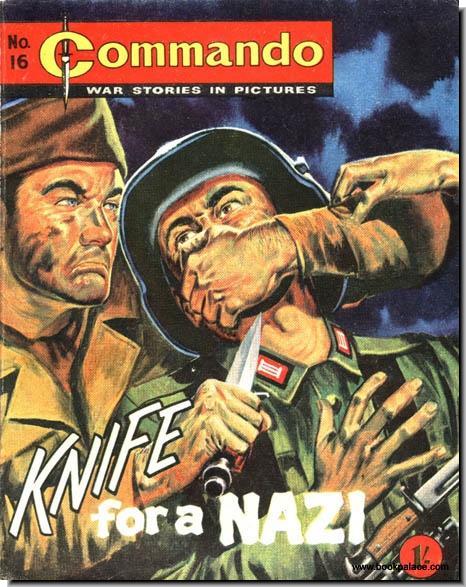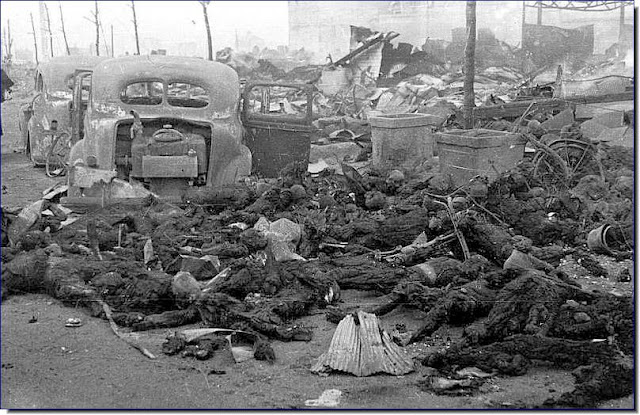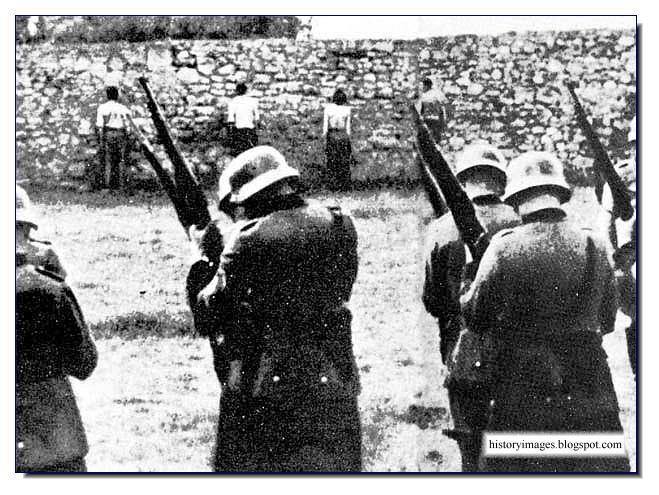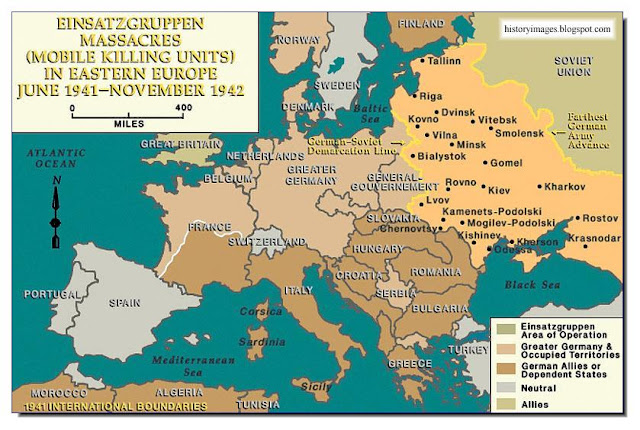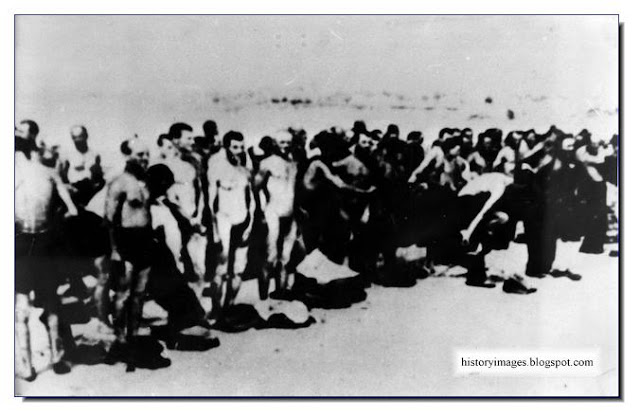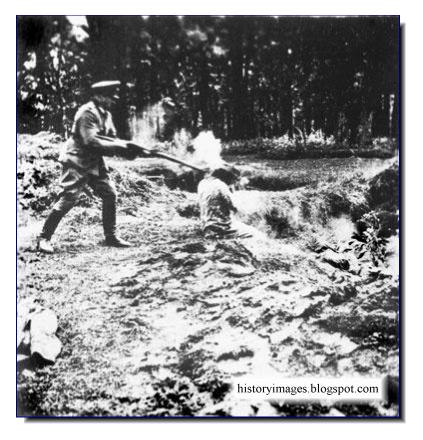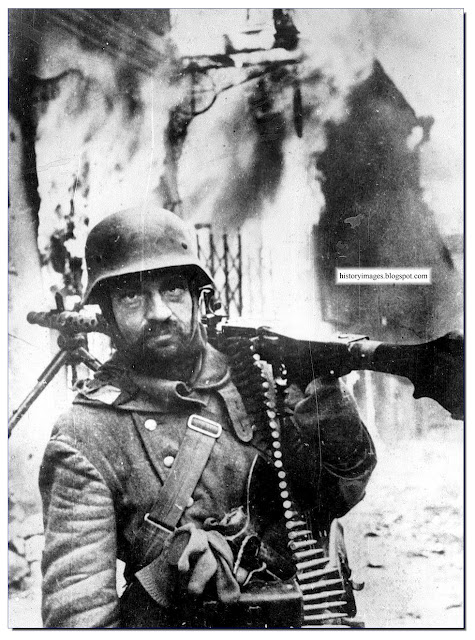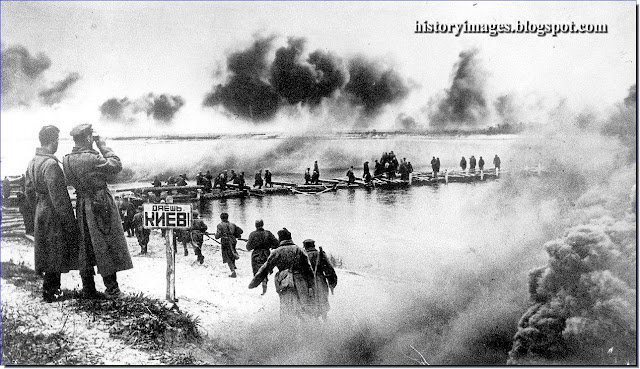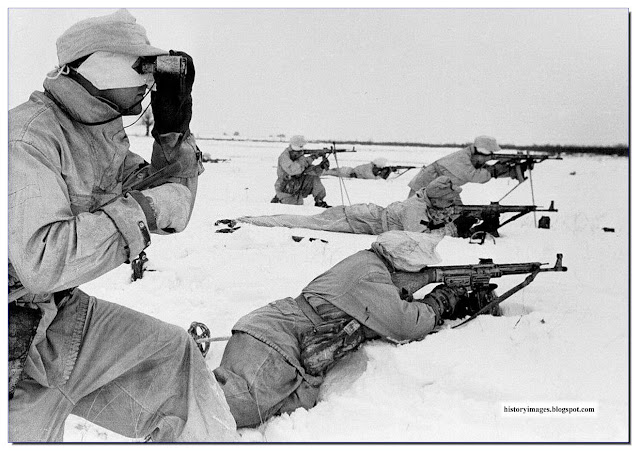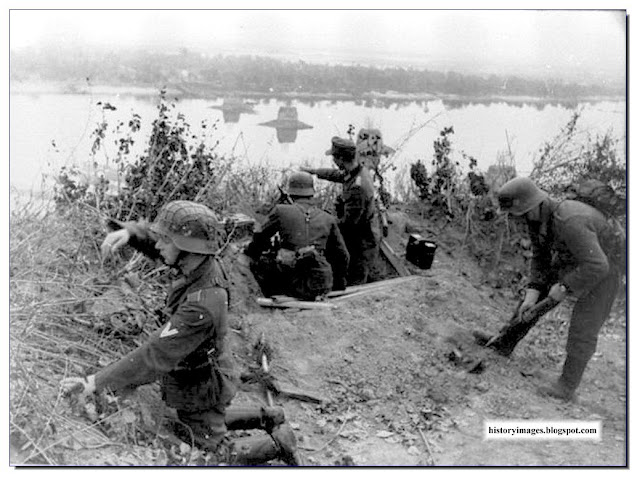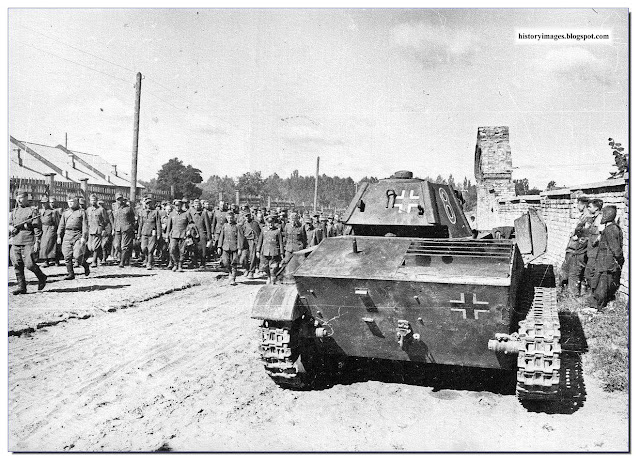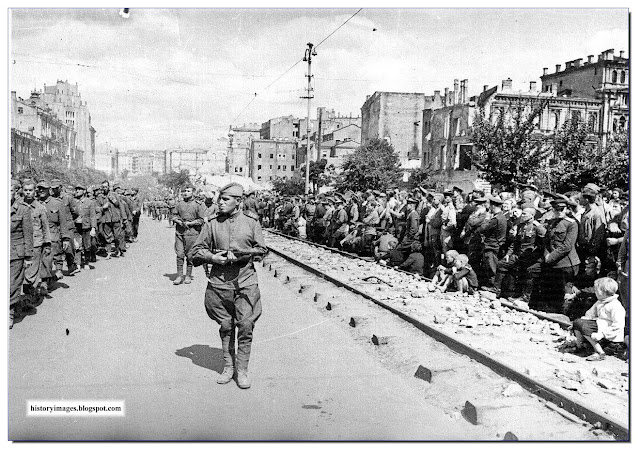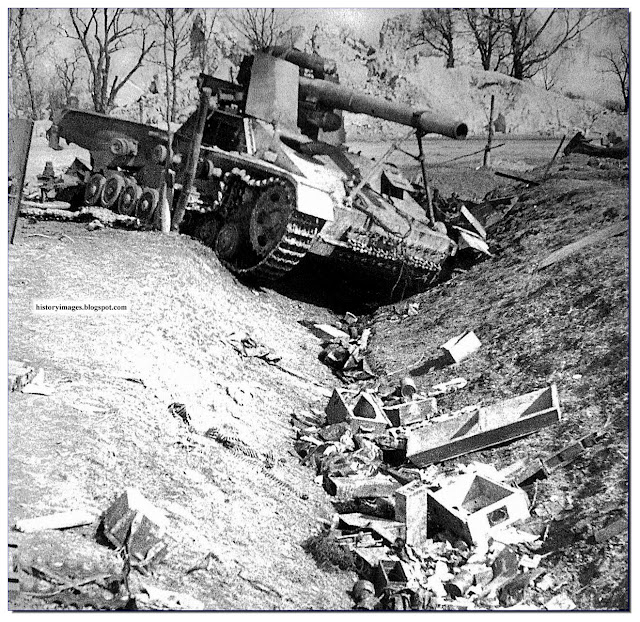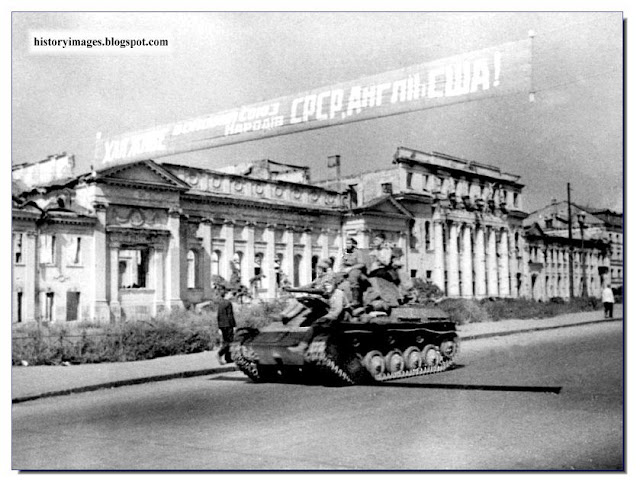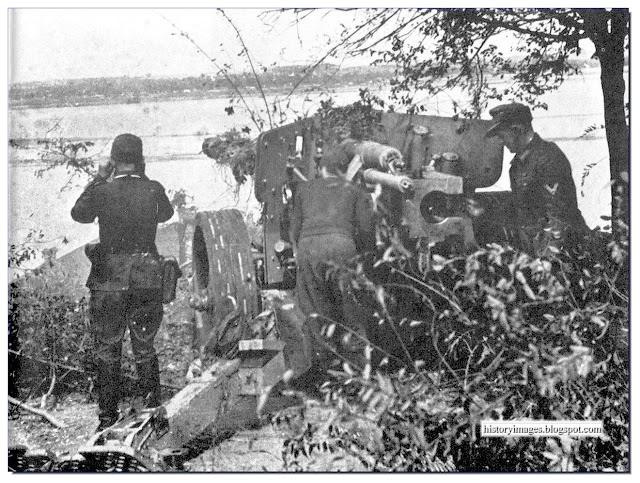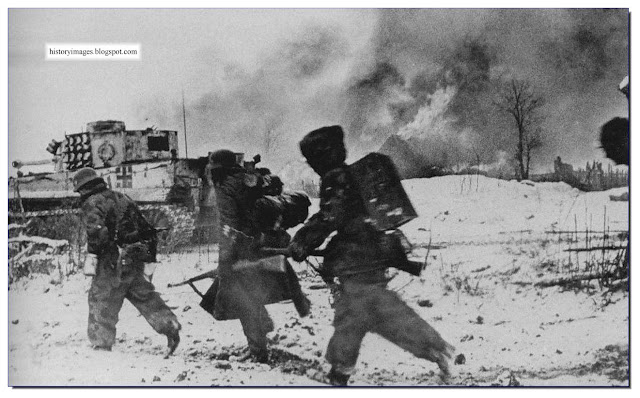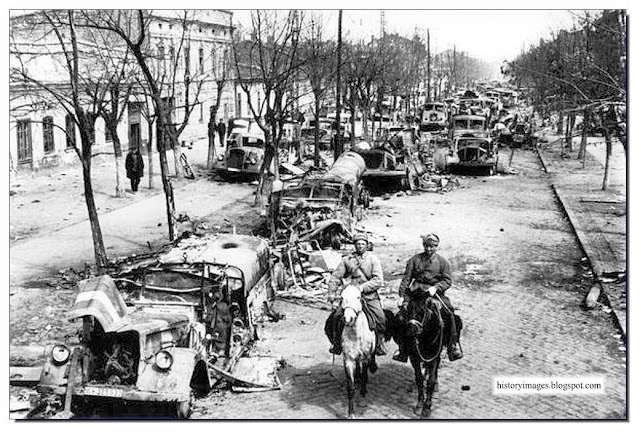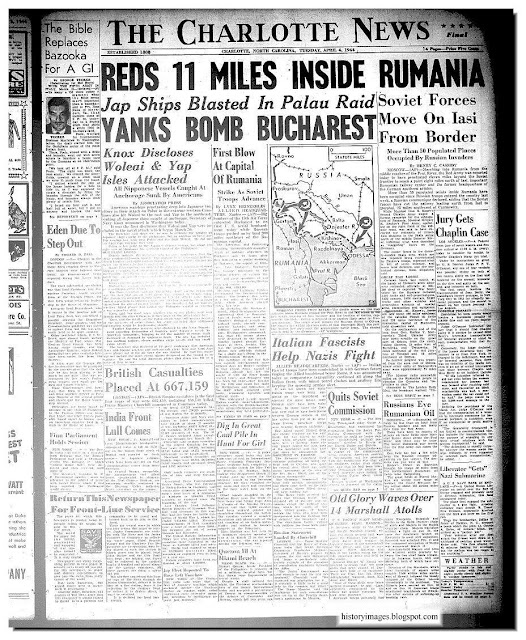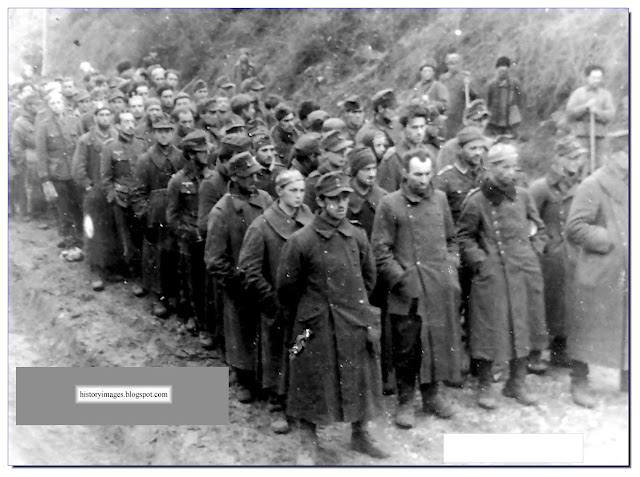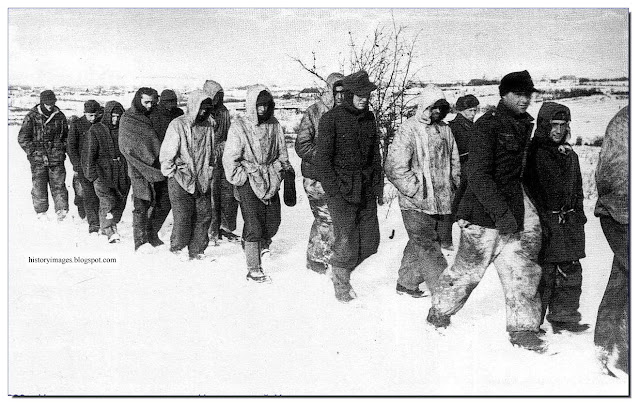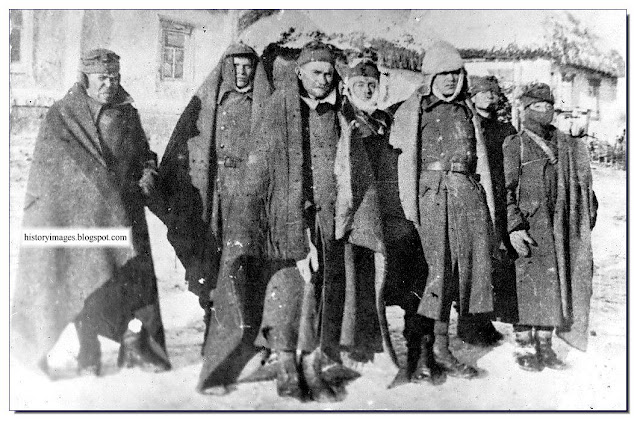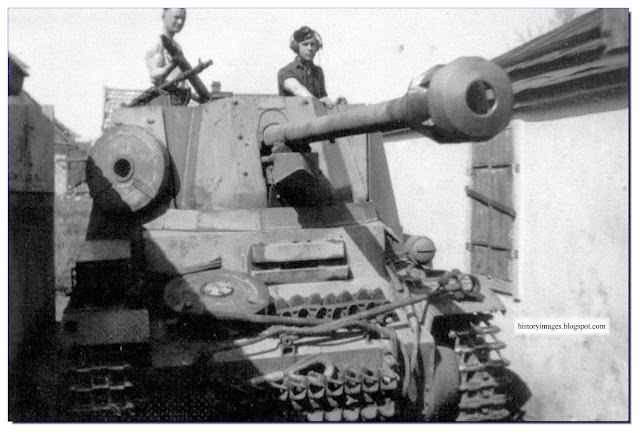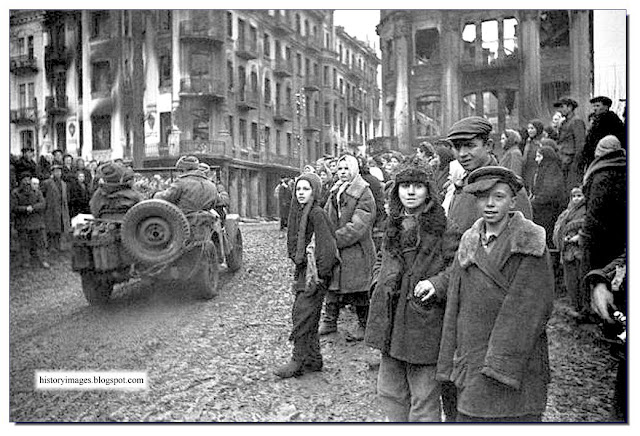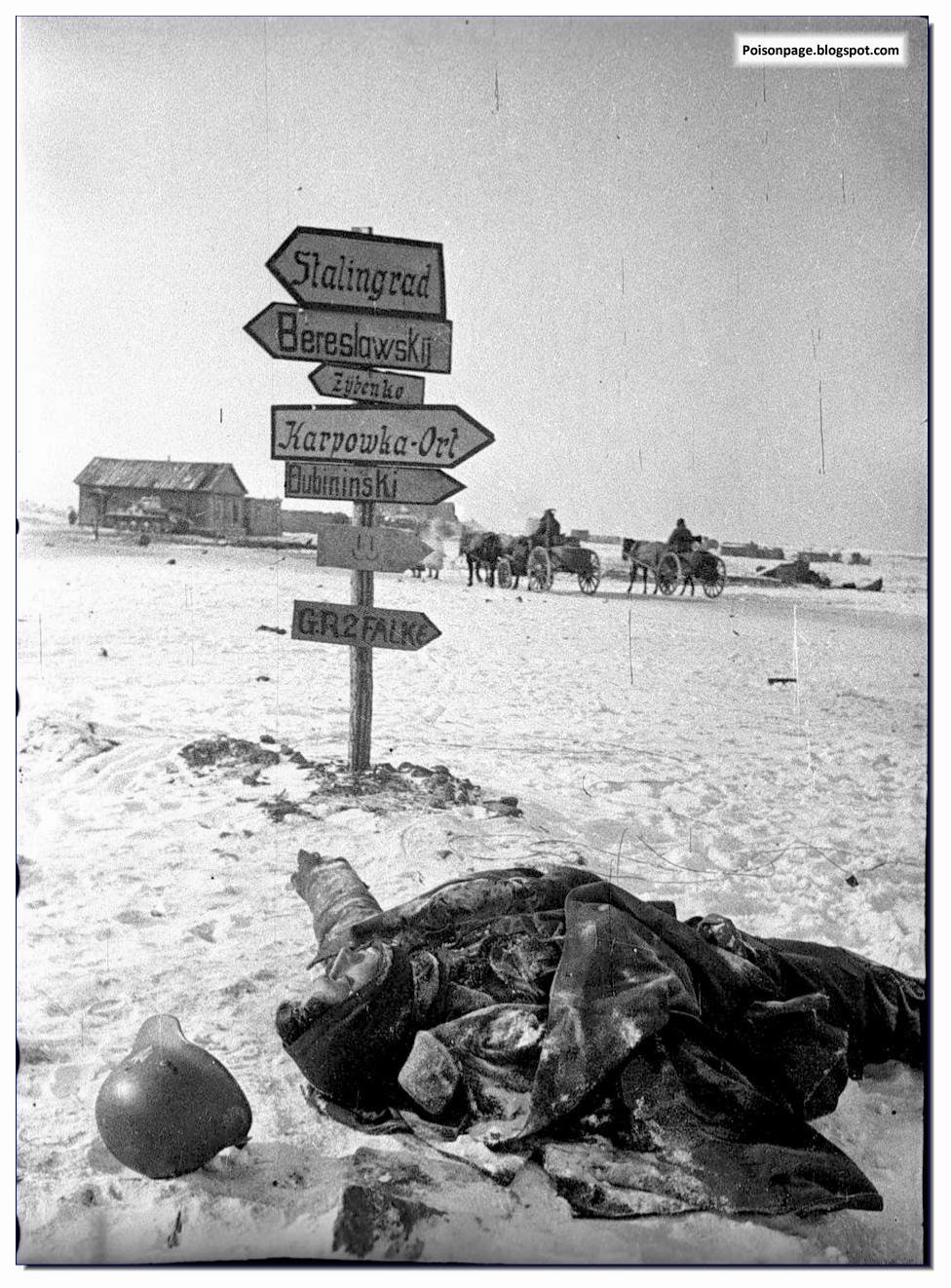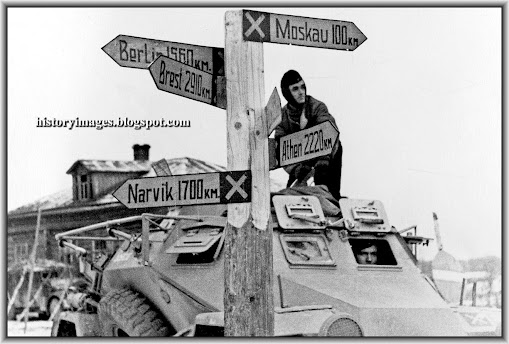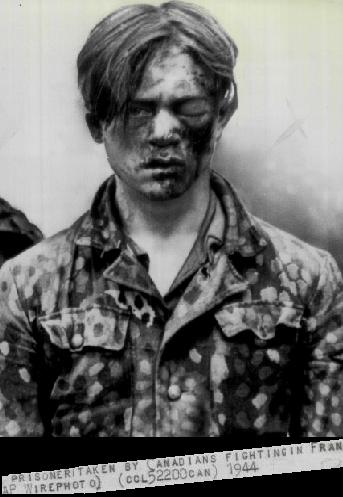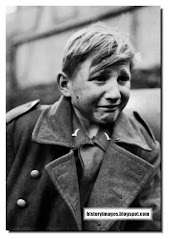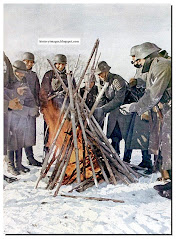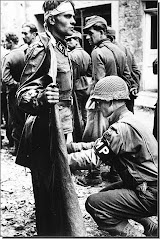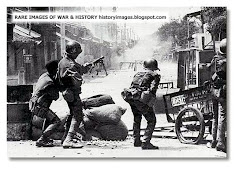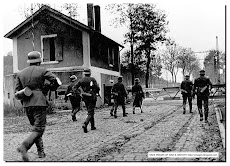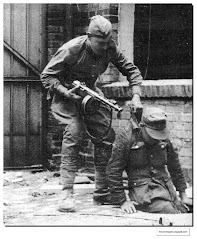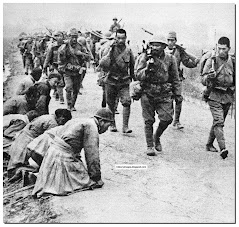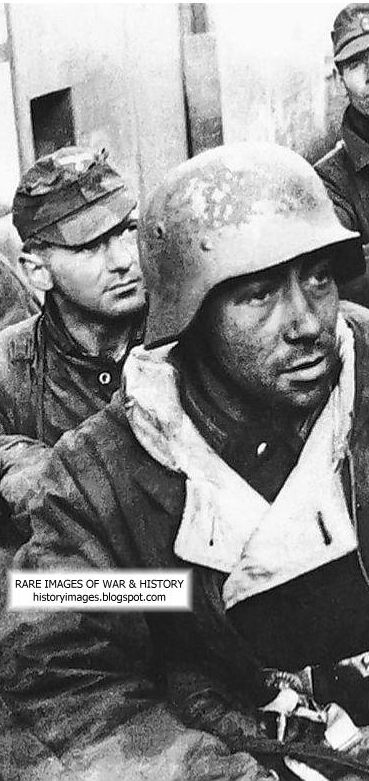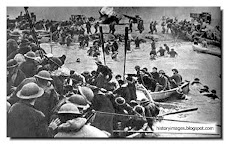Going about their daily work. Einsatzgruppe killing Poles.
Einsatzgruppen. In German it means an innocuous, "task force". In reality it embodied the evil side of Nazism. During World War Two it killed about 1.3 million Jews, gypsies and Soviet commissars. They were terminators, exterminators. Giving flesh and bones to Hitler's visceral hatred of Jews and the Untermenschen.
What is frightening is that they did the killings in a professional, well organised manner. Without pity. Just a mad devotion to the Fuehrer. It is certain that many of them were sadists. Nobody could kill such large number of humans without being slightly kinky in the head.
Of course, WW2 made almost everybody insane with hatred. The brutality of the Russian soldiers in Germany after it lost and even the many incidents of British and American soldiers' bestial behaviour towards German Waffen SS soldiers hardly shows them with a halo over their heads.
Nazism took roots in Germany only because the Allies humiliated it after WW1. It all starts with fear, hatred and the desire to dominate others. The vicious cycle never ends. But that is another story.

Einsatzgruppen in action
Formed by Heydrich, they comprised some 3,000 men in four groups of roughly battalion size. And, although Waffen-SS apologists have tried to deny any link between the Waffen-SS and these murder squads, the simple fact is that over a third (34 per cent) of their strength was drawn from the ranks of existing Waffen-SS formations.
Moving close behind the advancing front line so that few could evade their net, the Einsatzgruppen brutally shot, bayoneted, burnt, tortured, clubbed to death or buried alive almost half a million Jews in the first six months of the campaign. People were shot in the stomach to die in agony while their exterminators stood around joking and taking bets on how long they would last; babies had their heads smashed against walls to save ammunition; nobody was safe.
Yet even the men of the Einsatzgruppen sickened of the horror, von dem Bach-Zelewski himself suffering a nervous breakdown and others committing suicide through a surfeit of guilt. When Himmler attended the execution of 200 Jews in Minsk, even he was so revolted at the carnage that he ordered a new method to be found. From this stemmed the gas trucks and the later ovens.
The men of the Einsatzgruppen used all manner of psychological tricks to persuade themselves that what they were doing was 'right' after basic ideology failed. The Jews were not just civilians, but partisans, arsonists, saboteurs, couriers, spies and criminals.
Later, the Einsatzgruppen were actually to fight in an anti-partisan role as the Army (which cannot therefore absolve itself of guilt either) found their activities so 'useful'. Haider, the Army Chief of Staff in December 1941, said: 'these people [the Einsatzgruppen] are worth their weight in gold to us. They guarantee the security of our rear communications and so save us calling upon troops for this purpose'.
MIND OF THE EINSATZGRUPPEN MAN
(Special Motivation - The Motivation and Actions of the Einsatzgruppen by Walter S. Zapotoczny)
The Einsatzgruppen story offers insight into a fundamental Holocaust question of what made it possible for men, some of them ordinary men, to kill so many people so ruthlessly. The members of the Einsatzgruppen had developed a special motivation to kill.
The training that SS recruits received before their arrival in Pretzsch, prepared them very well for the new mission of the Einsatzgruppen. The SS was to be the living embodiment of the Nazi doctrine of the superiority of Nordic blood, and of the Nazi conception of a master race. SS candidates were thoroughly examined and checked. They were asked for the political reputation record of their parents, brothers and sisters, the record of their ancestry as far back as 1750 and their physical examination and any records from the Hitler Youth. Further, they were asked for a record of hereditary health showing that no hereditary disease exists in their parents and in their family. Last, but perhaps most important, was a certification from the race commission.This examining commission was composed of SS leaders, anthropologists, and physicians. The very process of selection and acceptance gave the new member a sense of superiority. Only pureblooded Germans in good health could become a member. He must have been of excellent character, had no criminal record, and been well versed in all National Socialist doctrines. The members had to be ready and willing tools, prepared to carry out tasks of any nature, however distasteful. Absolute obedience was therefore the necessary foundation stone of the SS. Obedience had to be unconditional. It corresponded to the conviction that the National Socialist ideology must reign supreme. Every SS man was prepared, therefore, to carry out blindly every order that was issued by the Fuhrer. The SS troops were also taught a view of the past based on racial struggle and Lebensraum (Living Space). The past provided a sense of continuity and showed the recruit that the Jews and Slavs had always been the enemies of Germany. This meant that the need for living space and a solution to the Jewish question was deemed inevitable. The SS soldiers, as well as the other men who arrived in Pretzsch, had also been exposed to the ideas of Euthanasia.
The killing by shooting, especially of women and children, had a devastating effect on many of the Einsatzgruppen member's mental state, which even heavy drinking of hard liquor (of which they were given a generous supply) could not suppress. A few committed suicide and some asked for transfer to other units. Units began experimenting with methods that would ease the burden on the shooters.
Clearly, the Einsatzgruppen record is one of brutality and devastation. They were indoctrinated to view Jews, Slavs, partisans, and Bolsheviks as threats to the German people. They viewed this people as sub-human. Through indoctrination and training, they developed a special motivation to conduct violence. This special motivation not only enabled them to kill, it enabled them to carry out cruel and bestial acts on their victims.
One theory that accounts for their behavior is based upon causal rather than correlation evidence is the violent-socialization theory of the American criminologist Lonnie Athens. Richard Rhodes describes his theory, in detail. Athens did not study violent officials. Some violent officials (notably police) are self-selected and come to the profession already experienced with violence, as many of the Einsatzgruppen did. For those officials who acquire their violent skills in official training, there are clear parallels between their training experiences and the four-stage development process that Athens identified in the backgrounds of violent criminals
Since violence, official or private, is learned through violent experience, such parallels are to be expected and should not be surprising. The violent socialization process, Athens found, divides into four stages, which he calls: brutalization; belligerency; violent performances and virulency. The stages are sequential. Each stage has to be fully experienced before the subject advances to the next one, a process that can occur cataclysmically in a short period of time or across a period of years. That violence is a choice rather than a compulsion or a release is taken for granted in the military and among police.
The attitude of most of the Einsatzgruppen can be summed up in a quote from SS General Otto Ohlendorf, commander of Einsatzgruppen D, during the Nuremburg Trials:
The men, women, deeply excavated antitank ditches. Then they were shot, kneeling or standing, and the corpses thrown into the ditch. I never permitted the shooting by individuals in group D, but ordered that several of the men should shoot at the same time in order to avoid direct personal responsibility.
He, like most of the Einsatzgruppen, expressed no remorse for his actions and was more concerned about the moral strain on those carrying out the executions than those actually being executed. He went to the gallows believing he had done his duty for his country. He, like most of the Einsatzgruppen, had a special motivation to carry out their work.
 |
| Einsatzgruppen A. Is man really any better than animals? |
Notably, the Einsatzgruppen included many high-ranking officers, intellectuals and lawyers. Otto Ohlendorf, who commanded Einsatzgruppe D, had earned degrees from three universities and achieved a doctorate in jurisprudence. One of the commanders of Einsatzgruppe C, Ernst Biberstein, was a Protestant pastor, theologian and church official.
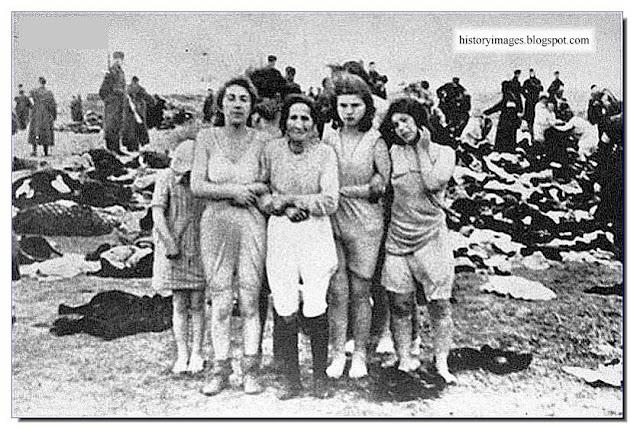 |
| Jewish women before their execution in Liepeja, Latvia. Sheer insanity. Hatred is terrible. |
EINSATZGRUPPEN NOT MERE KILLERS....
Axishistory
They were also a great source of intelligence on the conditions of the areas occupied by the German Army. In 1941-1942, clerks of the Reich Security Main Office (Reichssicherheitshauptamt - RSHA) compiled summaries of the reports they had received from the Action Groups (Einsatzgruppen) of the German Security Police and Security Service (Sicherheitspolizei und Sicherheitsdienst - Sipo u. SD) for very limited circulation. In 1945 a collection of most of these summaries, individually captioned "Operational Situation Reports USSR" and later "Reports from the Occupied Eastern Territories," was captured by American troops and subsequently used as evidence in the "Einsatzgruppe trial" conducted by a US military tribunal at Nuernberg.
Operational Situation Report USSR No. 20
Einsatzgruppe B:
Location: Minsk
The
industrialized areas are only slightly damaged. The town is without
light and water. Political and government officials have fled. The
population is very depressed. Many people have lost their shelter and
the food situation is worsening. To protect the communication lines and
prevent acts of sabotage, the Field Commander ordered the arrest of all
male inhabitants between the ages of 18-45. The civil prisoners are
being screened at this time. The attitude of the population toward the
Germans is one of wait-and-see. The Byelorussians show a friendlier
attitude towards the Germans. However, the entire population hopes that
the occupation will enable them to live a normal life in the near
future.
According to the last report of Einsatzgruppe B, wooden
houses in the western part of Minsk were set afire. Apparently the
houses were set on fire by Jews because the Jews were supposed to
evacuate their homes for returning Byelorussian refugees. At present the
population is in a mood to launch a pogrom. Their fury caused certain
anti-Jewish actions. A number of Jews were liquidated for this act.
Einsatzgruppe C:
Location: Rovno
1. Actions
On
July 5, 1941, 15 Jews were executed as reprisal for the bestial murder
of the Ukrainian nationalist leader Dr. Kirnychny in Rudki. The
Ukrainian population on their part set the synagogue and Jewish houses
on fire. 150 Ukrainians were found murdered in Stryj. In the course of a
search, it was possible to arrest 12 Communists who were responsible
for the murder of the Ukrainians. It concerns 11 Jews and 1 Ukrainian
who were shot with the participation of the entire population of Stryj.
Einsatzkommando 1b:
Location: Chernovtsy, Vorkommando at Khotin. The following was ascertained at Chernowitz:
1. The Rumanians declare North Bukovina to be Rumanian territory.
2. A great number of Jews of the poorer class are in Rumanian prisons. Nearly no intelligentsia.
3.
The Rumanians are inclined to exterminate the upper echelon of
Ukrainian leadership in order to settle the Ukrainian problem in the
North Bukovina once and for all, taking advantage of the present
situation. 22 Ukrainians are under Rumanian arrest in Chernowitz. lb has
been given the following orders in this respect:
a. To
influence the Rumanian authorities to take severe measures concerning
the Jewish question. They must raid Jewish meetings and uncover
conspiracies in order to stimulate Rumanian activities against the
Jewish intelligentsia and to enable us to take a hand ourselves.
b. To hold or to turn over to us important Ukrainians; similarly,
Ukrainian Communists will be put at the disposal of the Rumanians.

Einsatzgruppe C:
Location: Zhitomir
Zhitomir
had a population of 90,000, of which about 30% were Jews, 15% Poles,
the rest Ukrainians, and about 4,000 Volksdeutsche. Now there are
approximately 40,000.
Zhitomir is heavily damaged by arson committed by the Russians. The population greets the Germans as they march in.
Einsatzgruppe D:
Location: Piatra-Neamt
The Chief of the Security Police and the SD
Berlin July 20, 1941
36 copies
(27th copy)
Operational Situation Report USSR No. 28
Einsatzgruppe A:
Location: Pleskau [Pskov]
Einsatzgruppe
A has transmitted secret instructions (a copy of which is enclosed)
concerning the deportation of anti-Soviet elements from Lithuania,
Latvia and Estonia.
I. Following consultations with Army Group
South, the agreement stands that all the Einsatzkommandos as well as the
Group staff stay close to the fighting troops whenever possible. This
guarantees that the advance Kommandos as well as the main Kommandos will
march into Kiev as soon as possible after its capture, which is
expected shortly.
II. According to the report of an eyewitness
from Tarnopol, an officer of the German Air Force was led through the
city by the Russian police, followed by a large crowd of Jews, and was
insulted and ill treated. The population is in general convinced that it
is mostly the Jews who should be held responsible for the atrocities
that are committed everywhere.
IV. So far, a total of 240
executions have been carried out in Rovno: mostly Jewish Bolshevik
agents and informers of the NKVD. The advanced Kommando Lublin for
special tasks arrived here yesterday and together with the militia will
now proceed to undertake the further purging of the town and its
environs.
As it was learned that the Russians before they left
have either deported the Ukrainian intelligentsia, or executed them,
that is, murdered them, it is assumed that in the last days before the
retreat of the Russians, about 100 influential Ukrainians were murdered.
So far the bodies have not been found — a search has been initiated.
About
100-150 Ukrainians were murdered by the Russians in Kremenets. Some of
these Ukrainians are said to have been thrown into cauldrons of boiling
water. This has been deduced from the fact that the bodies were found
without skin when they were exhumed. In retaliation, the Ukrainians
killed 130 Jews with sticks.
In Dubno, where the activities have
essentially come to an end, a total of 100 executions were carried out.
Among them was a Ukrainian who since 1940 has worked without
interruption for the NKVD. He confessed he was responsible for the
murder or deportation of Ukrainians into Central Russia; in addition,
two Communist officials and confidants of the NKVD who instigated
sniper-warfare; one Communist who had revealed every activity of the
Ukrainian nationalists to the Russians and had initiated the evacuation
or deportation of many local families. Finally, there were also two
Russians who were found in possession of shoulder-straps, leather-wear
and army under-wear of German soldiers. Before leaving Dubno, the
Russians, as they had done in Lvov, committed extensive mass-murder.
Altogether
127 executions were carried out in Tarnopol. Before their flight, as in
Lvov and Dubno, the Russians went on a rampage there. Disinterments
revealed 10 bodies of German soldiers. Almost all of them had their
hands tied behind their backs with wire. The bodies revealed traces of
extremely cruel mutilations such as gouged eyes, severed tongues and
limbs.
The number of Ukrainians who were murdered by the
Russians, among them women and children, is set finally at 600. Jews and
Poles were spared by the Russians. The Ukrainians estimate the total
number of victims since the occupation of the Ukraine by the Russians at
about 2,000. The planned deportation of the Ukrainians al-ready started
in 1939. There is hardly a family in Tarnopol from which one or several
members have not disappeared. In the town, containing about 40,000
inhabitants, among them 12,000 Ukrainians, 18,000 Jews, and 10,000
Poles, there are fewer than 10,000 Ukrainians left. The entire Ukrainian
intelligentsia is destroyed. Since the beginning of the war, 160
members of the Ukrainian intelligentsia were either murdered or
deported.
Inhabitants of the town had observed a column of about
1,000 civilians driven out of town by police and army early in the
morning of July 1, 1941.
As in Lvov, torture chambers were
discovered in the cellars of the Court of Justice. Apparently, hot and
cold showers were also used here (as in Lemberg) for torture, as several
bodies were found, totally naked, their skin burst and torn in many
places. A grate was found in another room, made of wire and set above
the ground about 1m in height, traces of ashes were found underneath. A
Ukrainian engineer, who was also to be murdered but saved his life by
smearing the blood of a dead victim over his face, reports that one
could also hear screams of pain from women and girls.
The troops
passing by who saw these horrors, in particular the bodies of the
murdered German soldiers, killed approximately 600 Jews and burned down
their houses.

Smart uniforms, but they were killers
The Chief of the Security Police and the SD
Berlin, July 28, 1941
43 copies (32nd copy)
Operational Situation Report USSR No. 36
Einsatzgruppe B:
Location: Minsk
I. Police Activity:
a.
In the course of an extensive search action, 38 more persons were
arrested in cooperation with the GFP. A larger number of weapons, radios
and files has been secured. Further action led to the liquidation of
193 Jews. Two armed robbers caught red-handed were also liquidated. A
Jewish-Polish secret organization was discovered and was infiltrated by
secret agents. They will be uncovered only after more details are
available. An organization plan of the NKVD and NKGB was set up in
Vilnius with the assistance of secret agents. For the time being, one
cannot know for certain if this plan is complete in all its details.
b.
Until further notice, about 200 persons are being liquidated daily in
Minsk. This concerns Bolshevik officials, criminals, Asiatics, etc. They
are being sorted out from among civilian-camp prisoners. Among those
already liquidated were also the former politically oriented staff
commissar, Gregory Bylich, born 1890 in Lesog, and his wife. Both had
been very active in the deportation of Byelorussians to Siberia. Actions
were further carried out in Rakov, about 40 km from Minsk, and in the
forest region north of the Minsk-Borissov-Krupka line. 58 Jews,
Communist officials, and agents, prison inmates as well as soldiers in
plain clothes suspected of having contact with partisan groups, were
liquidated. In addition, 12 Jewesses who were proven to be agents for
the KP during the Polish campaign were shot.
c. Concerning their
KP memberships: Our experience up to now shows that a majority of
members at heart rejected the Bolshevik Weltanschauung [world outlook].
The Soviet leading class had exerted strong pressure on the population
to join the KP Those who refused were in many cases sent to Siberia,
thrown into prison or shot. The percentage of the population that was
forced to join the party varied, however, within the diverse groups of
peoples. In general, the Jews belong to the party out of inner
conviction. The same goes for the Russians who lived in Byelorussian
areas. Also the Poles were forced into memberships.
However,
coercion to join the KP was often the case with the Byelorussians. The
Kommandos have been ordered to consider these facts carefully in the
course of the liquidations.
II. Civilian Life Activity:
a.
The activity of the Roman Catholic Church, which has in the
Byelorussian area mainly Polish leadership, is very noticeable and
clearly attempts, with the Byelorussian clergy, to do missionary work.
b.
Preference of Byelorussian personnel for "leading and organizational"
positions in the former Polish areas as well as gradual removal and
relief of the Poles partly causes reactions in their mood.
c.
Ruthless requisitions have had a negative influence on the general
public mood as well as the prevailing conditions in Minsk and its rural
environs. A price list has been drawn up, and the question of wages was
handled in Minsk. Free trade will be opened up soon. The
Reichskreditkasse has granted the city of Minsk a substantial loan for
its reconstruction expenses. For the time being financial re-sources are
drawn from forced loans from the Jewish population. The appointed head
of the Minsk district has appointed an administrator of the kolkhozes
[collective farms]. The following immediate projects have been ordered:
A
survey of cattle and cultivated fields has to be drawn up;
further-more, all the distributions in the kolkhoz-factories were
cancelled. The immediate publication of a newspaper in the Byelorussian
language is planned. The first 5,000 copies are to be printed. The
con-tent: general information, German Army reports and news from the
front. For the time being, political issues are not to be touched. Radio
station Baranovichi lacks material to transmit; there are not enough
records either.
d. It is evident that the population rejects the
Bolshevik rule in the area around Orscha, Krupka, and Shklov, 200 km
east of Minsk; how-ever, this is so mainly for economic and social
reasons. The population is still greatly intimidated. Economic life is
completely paralyzed, food very scarce. The population rummages in
demolished places for things which they could use. Einsatzkommando 7b
has set up appointed town administrations in Krupka, Shklov and other
places. Four-fifths of Shklov are destroyed, mainly by arson. Citizens
are afraid to assume an office in the town hall for fear that the
leaders of the Komsomol might take revenge. We succeeded nevertheless in
forming a city council consisting of 8 Russians who carried out the
following:
1. Clearing of houses inhabited by Jews and placing
the Jews in ghettos (cases of leprosy and scabies were observed among
the Jews).
2. Distribution of flour to the population from army reserves.
3. Work in city kolkhoz was begun.
e.
The antagonism between Poland and Lithuania continues in the district
of Vilnius. Poles feel disadvantaged in the distribution of goods.
Lithuanians
believe that they have the right to arrest Poles and to confiscate
their belongings. There is, however, a general agreement with the
measures taken by the Germans, particularly with the proceedings against
the Jews. It was established that the above-mentioned Lithuanian
organization has dissolved spontaneously with the advance of the German
forces. The active forces went over to the activist [collaborating]
groups. Activity of Schaulists has increased in the university. Tension
between Fascist and Catholic groups can be noticed there. Fascist groups
are in the minority.


(Click to enlarge map)
Einsatzgruppen killing fields in Russia, June 1941 to November 1942 (Click to enlarge map)

Einsatzgruppen's work in USSR, November 1941 (Click to enlarge map)
Jews being led to Babi Yar. Kiev. September 1941
Another government department. Einsatzgruppen administration in Russia
USSR 1941. Jews being made to undress being being shot by the Einsatzgruppen
Pinsk, Belarus. 1941
Lubny, Ukraine, Einsatzgruppen C SS officers in the unit club, 1941.
The killers in action.
Slutz, Belarus. Hunting for Jews. Hard to forget this.
AN AVERAGE EINSATZGRUPPEN KOMMANDO'S LETTER HOME....
THE EINSATZGRUPPEN HALL OF FAME
Eberhard Karl Schöngarth (22 April 1903 — 16 May 1946) was a German Nazi, appointed SS-Brigadeführer und Generalmajor der Polizei (Brigadier General) on Himmler’s orders in 1943. He was a war criminal who perpetrated mass murder and genocide in occupied Poland during the Holocaust.
Schöngarth was captured by the allies at the end of the war. After investigating his background, he was charged with the crime of murdering a downed Allied pilot (on 21 November 1944) and tried by a British Military Court in Burgsteinfurt. He was found guilty of this offence on 11 February 1946 and sentenced to death by hanging. Schöngarth was hanged by Albert Pierrepoint on 16 May 1946 at Hameln Prison.

SS-Gruppenführer Arthur Nebe (13 November 1894 – 21 March 1945) perpetrated mass murder in the Holocaust, serving as commanding officer of Einsatzgruppe B deployed in the Bezirk Bialystok district (modern Belarus) behind Army Group Centre during the German invasion of the Soviet Union. Arthur Nebe was involved in various plots including the 20 July 1944, bomb plot against Hitler. As part of the plot, Nebe was to lead a team of 12 policemen to kill Himmler but the signal never reached him. Historian Reitlinger characterized Nebe as "a very questionable member of the Resistance Circle at the time of the great bomb plot." After the failure of the assassination attempt he went into hiding on an island in the Wannsee but was later arrested after a rejected mistress betrayed him. Nebe was sentenced to death by the Volksgerichtshof (People's Court) and according to official records, was executed in Berlin at Plötzensee Prison on 21 March 1945, by hanging with piano wire from a meat hook as that was the punishment ordered by Hitler – who wanted the July 20 conspirators to be "hanged like cattle"

Karl Jaeger (20 September 1888 – 22 June 1959) was a Swiss-born SS-Standartenführer (Colonel) and Einsatzkommando leader.
Among all Nazi documents detailing calculated acts of mass murder and other atrocities, the "Jäger Report" is one of the most horrifying. It provides a detailed account of the murderous rampage of this "special squad" in Nazi-occupied Lithuania. Jaeger was instrumental in the brutal and systematic destruction of the Jewish community of Lithuania.
Jaeger escaped capture by the Allies when the war ended, assumed a false identity, and was able to assimilate back into society as a farm hand until his report was discovered in March 1959. Arrested and charged with his crimes, Jaeger committed suicide in prison in Hohenasperg while he was awaiting trial in June 1959.
Otto Ohlendorf (4 February 1907 – 8 June 1951) head of the Inland-SD (responsible for intelligence and security within Germany), a section of the SD. Ohlendorf was the commanding officer of Einsatzgruppe D, which conducted mass murder in Moldova, south Ukraine, the Crimea, and, during 1942, the north Caucasus.
During the trial against Einsatzgruppen leaders, Ohlendorf was the chief defendant, and was also a key witness in the prosecution of many other indicted war criminals. Ohlendorf's frank, apparently reliable testimony was attributed to his distaste for the corruption that was rampant in Nazi Germany and a stubborn commitment to duty. He expressed no remorse for his actions, telling the prosecutor that the Jews of America would suffer for what the prosecutor had done, and seemed to have been more concerned about the moral strain on those carrying out the executions than those actually being executed. Otto Ohlendorf was sentenced to death and hanged at the Landsberg Prison in Bavaria shortly after midnight on 8 June 1951.

Dr. Martin Franz Erwin Rudolf Lange (18 April 1910 – 23 February 1945?) was a prominent Nazi police official. He served as commander of the SD and SIPO in Riga, Latvia. He participated in the Wannsee Conference, and was largely responsible for implementing the extermination of Latvia's Jewish population (Einsatzgruppe A killed over 250,000 people in little less than six months).
Lange was said to be killed in action in Posen, Warthegau in February 1945; he may have committed suicide, but records are unclear. He was one of the few SS officers to receive the German Cross in Gold medal on 6 February 1945.
Lange was said to have been a favorite student of Reinhard Heydrich and Heinrich Himmler. He demanded unconditional obedience from his subordinates. Joseph Berman, a survivor of one of the concentration camps administered by Lange, described him as follows:
As far as Lange is concerned, he was the biggest murderer I have ever known. To write a book about him would definitely not be enough. As he is dead, it is no use talking about him. I would, however, mention that he was one of the most notorious anti-Semites in the twentieth century. He hated Jews so much that he could not look at them; one never wanted to pass him either in the motor pool or anywhere else
Bruno Heinrich Streckenbach (7 February 1902 – 28 October 1977)
Streckenbach was taken prisoner by the Soviets and, in 1952, he was sentenced to serve twenty-five years in prison, but was released on 10 October 1955. During the Nuremberg trial, defendant SS-Brigadeführer Otto Ohlendorf stated that Streckenbach, in mid-June 1941, had transmitted the extermination order, at a meeting concerning the missions of the Einsatzgruppen.
The West German government eventually brought Streckenbach to trial in 1973 but the case was dismissed due "to the defendant's poor health". He died on 28 October 1977, at home, in his birthplace Hamburg.
Franz Walter Stahlecker (10 October 1900 – 23 March 1942) commanded Einsatzgruppe A, the most murderous of the four Einsatzgruppen. He was killed in action on 23 March 1942, in a clash with Soviet partisans near Krasnogvardeysk, Russia.
Suggested Reading
Excepts
The German sponsored violence against Jews in Lithuania
"
"

